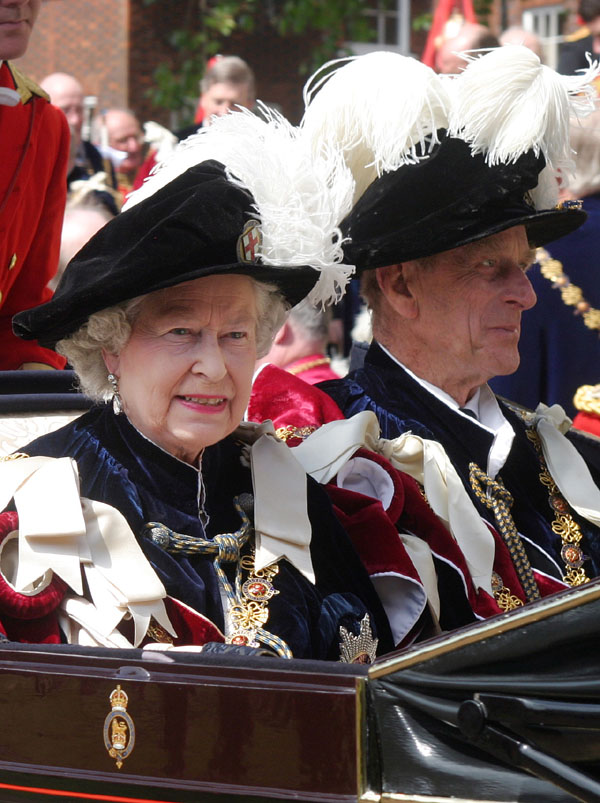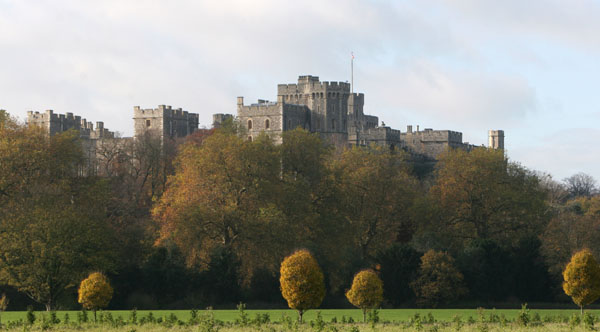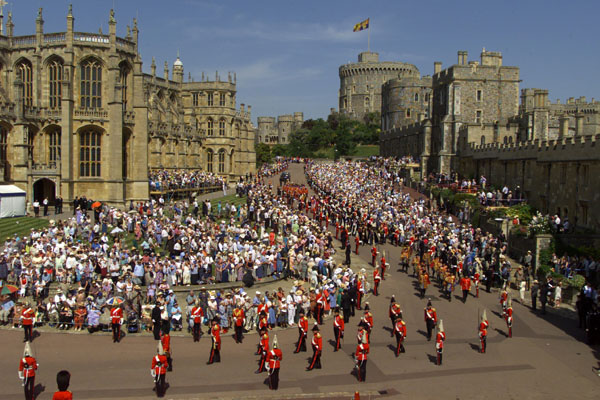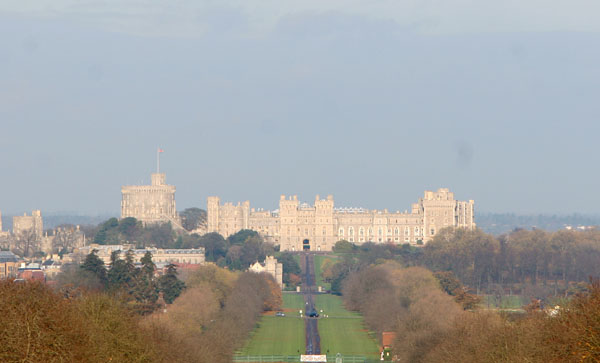Attention, fans of the British Royals. A regal treat is in store for you, as the fab documentary, The Queen’s Castle, is set to debut on public television stations in the US later this month.

Approved by Queen Elizabeth II and filmed over the course of a year, The Queen’s Castle takes viewers where Windsor’s one million annual tourists rarely go: behind the scenes.
Through exclusive access granted to the producers, we meet many of the 300 staff members (160 residents) who keep the 1,000-year-old Windsor Castle running tickety-boo, get an insider’s view of the daily goings-on and extraodinary events at the world’s largest lived-in and longest-inhabited castle (since Henry I in the early 1100s), and hear from HRH The Duke of Edinburgh, Prince Philip.
The Queen’s Castle (titled Windsor Castle: A Royal Year when it aired nationally on PBS) is narrated by actress Barbara Flynn (The Queen) and shown in three parts, including:
“The Banquet”
The opener introduces us to several members of Windsor’s staff, including (the humorous) Castle Superintendent Major Alan L. Denman, who inspects the royal grounds each morning before Windsor Castle is opened to the public. Compared to Annette Wilkin, the Queen’s housekeeper, Denman is a true newbie. He’s been in his job for a year (at the time of filming), whereas Wilkin, who manages the tending-to of state apartments, private and guest suites, and some offices and staff areas, has worked at the 13-acre Windsor Castle since 1974.
Since William the Conqueror had Windsor constructed after the Battle of Hastings in 1066, the castle has withstood the ravages of wars and wicked weather. So it’s a tad ironic that one small modern gadget was the cause of a massive fire that nearly burned it to the ground in 1992. Prince Philip, who’s lived at the Castle for more than a half-century, gives viewers insights about the fire and the restoration of Windsor, which he oversaw.

Regarding the titular banquet, it is “the grandest royal occasion of the year” — a special state banquet for (then) French President Jacques Chirac, to celebrate 100 years of the Entente Cordiale. It is also the first-ever function at Windsor Castle for which a West End musical, specifically Les Misérables, is performed — complete with four tons of equipment, 25-piece orchestra, and 41-member cast.
Putting on such an important and large-scale event (nearly 140 attendees) takes six months’ worth of planning and keen attention to detail, since the Queen inspects nearly everything, down to certain small items in Suite 240. And every member of Windsor’s staff is involved, including the Master of the Household Vice-Admiral Sir Tom Blackburn, Deputy Master of the Household Edward Griffiths, Assistant to the Master of the Household Andrew Farquharson, Royal Chef Mark Flanagan, Yeoman of the Cellars Robert Large, Yeoman of the Glass Pantry Stephen Marshall, Royal Librarian Lady Jane Roberts, Senior Picture Conservator Rupert Featherstone, and Castle Flagman Tony Martin, whose job is “to raise the [24′ x 12′] Royal Standard the moment the Queen is inside the ramparts.”
(Watching the preparations for the banquet is a sight to behold. Nerve-racking, too, but admittedly nowhere near the levels of stress the staff must have experienced on that day.)
“Four Seasons”
Windsor Castle is not a museum that empties out when tourists leave, but a home to the live-in staff and the British Royal family, who return here most weekends. And in this episode, we get to participate vicariously in “the rituals and events which form the framework of the Royal year,” which begins at Windsor with Easter and what’s known as Easter Court, the traditional one-month period during which the Queen conducts her official engagements from Windsor in Berkshire County instead of Buckingham Palace in London.
The first of two grand events held at Windsor in June is Garter Day, the colorful ritual established in 1348 by Edward III, the first monarch in England/Britain’s more than 40 reigns to appoint Knights of the Garter. In the present day, Garter Knights and Ladies are former politicians, national heroes, and long-serving representatives of the Crown chosen by the Queen for the honor.
Also participating in Garter Day are the Military Knights of Windsor, “a collection of distinguished old soldiers who lend dignity and symbolism to events at St. George’s Chapel throughout the year,” as well as the Queen’s Master of Ceremonies, the Comptroller Colonel Sir Malcolm Ross, who is responsible for ensuring that the Garter procession goes off without a hitch, and Garrison Sergeant Major Billy Mott, who is in charge of those who guard the popular public procession from possible interlopers.

The Queen’s horses, including the Windsor Greys kept, cared for, and trained at the Castle’s Royal Mews by Stud Groom Terry Pendry, pull the royal carriages in the Garter Day procession, as well as at the second grand event in June: the Royal Ascot, the annual horserace established by Queen Anne in 1711.
The Ascot segment is the most fun (and funny) in the documentary, what with the celebrities (including Downton Abbey‘s Julian Fellowes and eternal entertainer Sir Bruce Forsyth), the breaking of fashion rules, and the bookies taking bets on what color of hat the Queen will wear on Ladies’ Day.
After the Royal family leaves in August for Balmoral Castle in Scotland, we meet Windsor’s governor and temporary king of the castle, Air Chief Marshal Sir Richard Johns, as well as Castle clockmaker Steve Davidson. The latter doesn’t make clocks; rather, he looks after all the ones across the Windsor estate. One of his lengthiest tasks is the setting of all 450 clocks back one hour in the autumn and forward in the spring — from the Castle itself, to the Prince Consort’s Farm, to the former Royal residence at Frogmore House.
The shorter segments that close out this episode (and mark the beginning of the end of the Royal year) feature: members of the resident garrison; the traditional Changing of the Guard at Windsor; the Castle’s bellringers; and Christmas at Windsor.
“The Ranger”
The final episode focuses roughly half of the one-hour run-time on Prince Philip, the longest-serving Ranger of the Great Park in history. (Until the filming of The Queen’s Castle, he had never given an interview while performing his rounds of the Windsor grounds.) In addition to his Ranger duties, the Duke of Edinburgh serves as the president of (and a carriage-driving competitor in) the international Royal Windsor Horse Show. He is also an idea man; he opened the estate’s farm shop and created a new deer park at Windsor.
Interspersed between the Prince’s segments are, amongst others, ones featuring: St. George’s Chapel and the new Cloister Shop; more of Major Denman, who is still discovering many parts of the Castle; the friendly rivalry between two dairy farmers, which culminates in the competition at the Royal Forest Agricultural Show (whose cow will be the dairy queen?); the Cartier International Polo Tournament, where Prince Harry is the star attraction (and the Hoff is another); a brief look at the Windsor art collection; and a star-studded event for the Prince’s Trust, attended by celebrities such as Joseph Fiennes and Eric Clapton.
The grand finale: the wedding celebration of Charles, the Prince of Wales, and Camilla, the Duchess of Cornwall.

It’s been a number of years since I’d first watched The Queen’s Castle, and rewatching it was a reminder that it’s unlike any documentary about the British Royals and Windsor Castle that I’d ever seen (and I’ve seen plenty) — no doubt attributable to the unprecedented access given to the producers. But the footage itself, while wonderful, isn’t what had me smiling broadly or getting teary-eyed during certain segments. I felt emotional because of the fabulous stories and the incredible history and traditions revealed through the footage, as well as the legacies the British Royals will leave for future generations at and beyond Windsor Castle.
The public TV stations listed below are confirmed for broadcasting The Queen’s Castle starting 30 June 2015. Check your local listings or contact the station that serves your area for air dates and times. For additional information about the program and carriage, contact American Public Television.
__________________
Add your comments on our Facebook, Google+, and Twitter pages.









